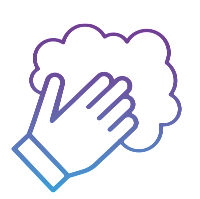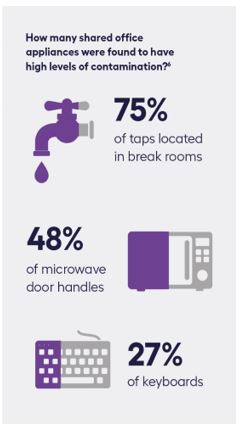What are we doing?
12th May 2020
Building the new way of working, together
The pandemic we are living through has highlighted the importance of hygiene and good standards of cleaning – whether it is at work, at home or in our public spaces.
But when restrictions are lifted and organisations begin to return to business as normal, how can you reassure your workforce and customers, and protect against future outbreaks?
Changes in the way we work, and behaviour may be here to stay. Working from home was largely a success and there has been some reluctance for employees to return to their place of work and we want to make sure we are doing all we can to help facilitate any transition and reassure people on the steps we are taking.
The lessons from China are clear: rebuilding employee and customer confidence is critical – especially with potential for further shutdowns on a local or national scale – here at Landmark we are doing all we can to actively explore solutions that are going to help our clients return to work as quickly and safely as possible…we feel it’s a chance to work with them on what the future looks like and it can be a positive thing, in a way it’s chance for a clean start…
What are we doing?
Over the next few weeks will be sending updates on what we are doing at Landmark to make sure we can all return to our centres safely as possible. To start the series, we want to tell you about one of the most important areas…cleaning.
Our Cleaning Approach
 The current crisis has turned the spotlight on cleaning operatives. We see that we have two parts to play, one in the preparation before our clients return and two the ongoing cleaning and hygiene of our spaces.
The current crisis has turned the spotlight on cleaning operatives. We see that we have two parts to play, one in the preparation before our clients return and two the ongoing cleaning and hygiene of our spaces.
Landmark believe cleaning, like maintenance, should be preventative, not reactive. Our proactive approach to deep cleaning reduces the risk of onward transmission and infection by cleaning shared workspaces and touchpoints such as keyboards, light switches and lift keypads. After a thorough clean, we will then work with you to design a schedule of deep cleaning to maintain standards of hygiene. So, when things return to normal and people have long forgotten to hum a tune while they wash their hands – or even to wash their hands at all[1] – how will we be keeping our clients safe?
Use the COVID-19 downtime to deep-clean your premises – With many buildings closed due to the pandemic, we are using this time to deep-clean buildings, focusing on vehicles of spread such as door handles and washrooms, so that your employees can feel confident that they are returning to a hygienically clean workplace. In China, the relaxation of restrictions led to a surge in demand for deep-cleaning services such as decontamination.
More frequent, intensive cleaning
Increase in the cleaning specifications during the pandemic to focus on daily cleaning of touchpoints that previously might have been carried out once a week. Maintaining frequent cleaning of high-contact surfaces such as door handles, stair rails and hand-dryers will create a safer environment for returning employees and customers and help to rebuild confidence.
In the longer term, a rigorous cleaning regime can keep your workforce safe from seasonal viruses and reduce sickness absence. The Healthy Workplace Project, a 2012 study by Kimberly-Clark in consultation with Dr Charles Gerba, Professor of Microbiology at the University of Arizona, collected nearly 5,000 individual swabs from office buildings housing more than 3,000 employees from different sectors. It found that 75% of taps located in break rooms had high levels of contamination (an ATP count of 300 or higher), as well as 48% of microwave door handles and 27% of keyboards.[1] Cleaning regimes should evolve to focus on such touchpoints and areas of high footfall.
To maintain hygiene and prevent future outbreaks, deep cleans should also become a regular feature of cleaning regimes. These will not only ensure the safety of your premises but will also help to protect and maintain your assets. The focus should be on the wellbeing of a building’s inhabitants and not their perception of whether it looks clean.
Make the invisible workforce visible – Cleaning regimes are often pushed to the beginning and end of the day, but cleaning needs to be continuous to maintain high standards of hygiene – and reassure returning employees and customers. Research from the University of Arizona found that contamination levels peak at lunchtime.[1] In fact, the 2013 study found that more than half of commonly touched surfaces in an office – door handles, photocopiers, the office refrigerator – can become infected with a virus when a single person in the office is ill. We want to make your cleaning team visible by having them on hand throughout the day so that they can be reactive, focusing their efforts on areas of high footfall and vehicles of spread. Reserve more intensive cleaning for out of hours.
Listen to the experts – From our hands to our cars to our homes, we all clean… but that does not make us cleaners. Our cleaning operatives are trained to clean in a specific way – for example, in a systematic way covering all areas of a room, from high points to low – using cleaning chemicals, disinfectants and technology with a kill rate of 99.9%. By following the correct risk assessments, safe system of work and method of cleaning, a skilled cleaning team can help you maintain a safe environment for your employees and your customers.
[1] https://uanews.arizona.edu/story/germs-spread-fast-at-work-study-finds
[1] https://uanews.arizona.edu/story/germs-spread-fast-at-work-study-finds

